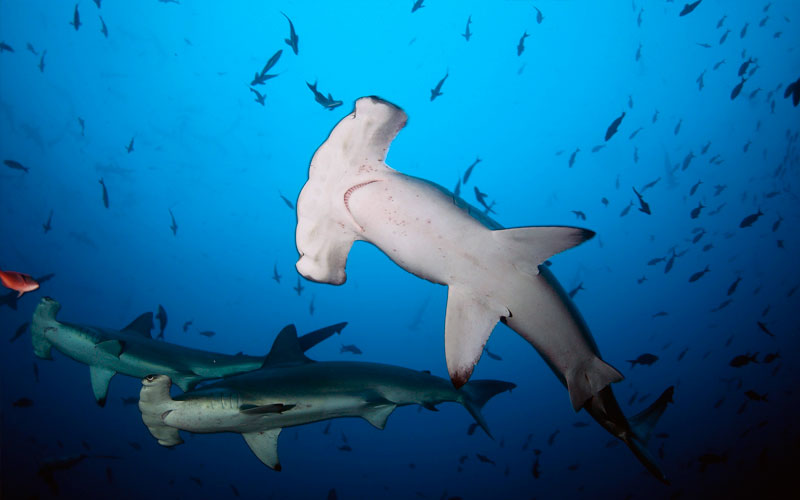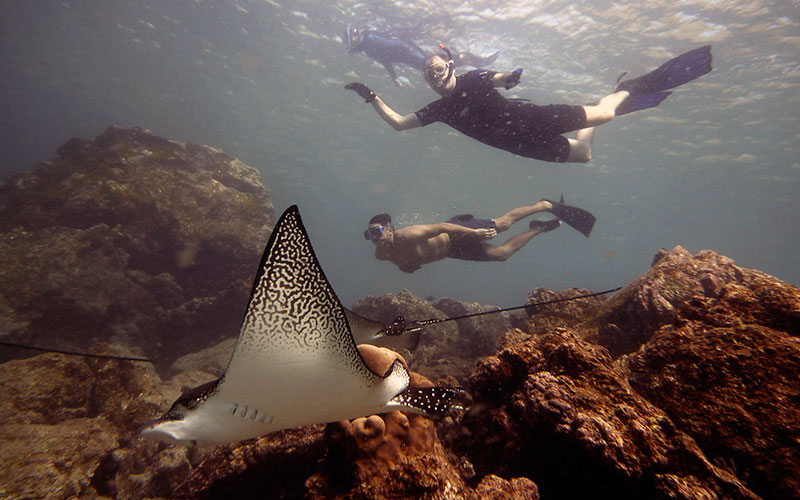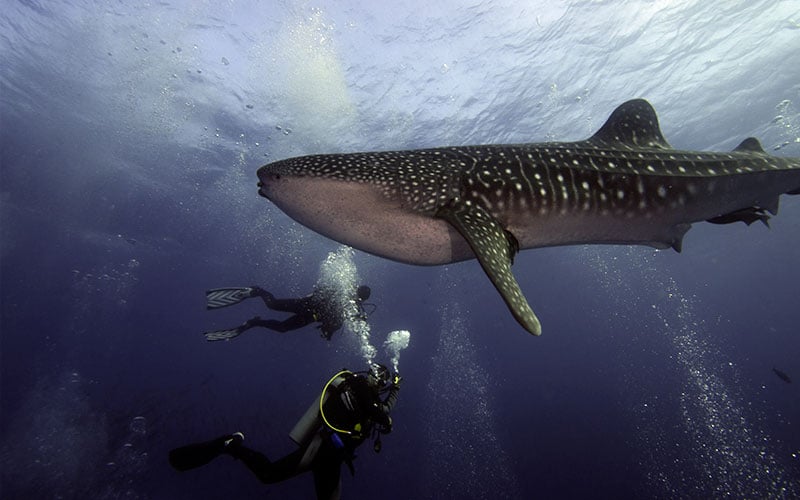“Best kept secret about the Galapagos” offered my Galapagos guide friend, and it’s true, Galapagos diving is often completely overlooked by many travellers because there’s just so much to see and do on the actual islands. But just this summer back in July 2017 experienced divers voted on a specialist dive website that the Galapagos oceans have four of the top 40 dive sites in the world. Considering that it’s actually divers themselves who voted for Galapagos dive sites to make up 10 per cent of the World’s top dive sites then you can rest assured that diving here is definitely worth your consideration.
In fact Galapagos diving kills the opposition in Australia, South Africa, Indonesia and Thailand and only the Egyptian Red Sea scored higher but as most astute divers will know, the two locations are like chalk and cheese.
Galapagos diving is without doubt the best cold ocean diving location in the world and quite distinct from most other popular dive sites in the world such as those in Egypt and Australia. So let’s do a roll call for Gordon’s Rock, Darwin Arch, Darwin Island and Wolf Island, the four Galapagos dive sites mentioned in the poll. Punto Espejo, North Seymour and Leon Dormido or Kicker Rock are other popular Galapagos dive sites.
CEDAM International, which in their own words is “a unique, not-for-profit organization dedicated to the preservation and conservation of the marine environment”, named the Galapagos ocean waters as one of the Seven Underwater Wonders of the World.
So what is all the fuss about?
Truth be told, and you will have read this before, the Galapagos Islands and the Galapagos ocean waters are just unique. Here, six ocean currents collide creating an ecosystem just as diverse as that on the land above. It’s very probable you’ll witness large marine animals such as orcas; hammerhead, whale, black and white tip, silky and Galapagos sharks; dolphins; manta and eagle rays; sea lions; turtles; the weird bullet-shaped mola-mola otherwise known as the ocean sunfish that can weigh up to 2,000 lbs; and even marlins in addition to endemic species such as marine iguanas, the endemic Red-Lipped Batfish and flightless cormorants – efficient predators once they dive underwater seeking out octopus and squid. Just the overall number of corals, fish and sea mammals is unparalleled to almost anywhere else in the world; it’s not for nothing that the Galapagos oceans are nominated as a marine wonder of the world.

It’s common to see large schools of fish including snappers and jacks, millions of black striped salemas that can be found at Punta Vincente Rock along with many sea lions devouring them. At Wolf Island you can often be surrounded by up to a hundred hammerheads with visibility at 50 meters. Even though hammerheads are known to be man-killers there are no known instances of an attack in the Galapagos. This sight alone is a bucket-list entry for seasoned scuba divers
Some of the dive sites can only be reached if you are on a ‘Live Aboard’ cruise such as the Darwin and Wolf Island dive sites but you can make the Gordon dive site and North Seymour on a land-based trip.These live aboard diving expeditions are for advanced divers normally. Conditions can be challenging due to strong currents and sometimes poorer visibility. Galapagos ocean waters are cold so you will need a 7mm wetsuit and maybe even a dry suit if you’re particularly sensitive to the cold as the water temperature can be as low as 16 Celsius. Bear in mind though that once up at the surface the water temperature might be as high as 30 Celsius in the warm season. Most live aboard boats will offer 4 dives a day so the probabilities of seeing your wish-list marine animals are high. For example, there’s a great chance you’ll see amazing whale sharks at Darwin and Wolf Islands.
The world famous Gordon Rock dive site, world famous among the diving community that is, is rated by CNN travel as the 6th best dive location in the world. This dive site is just a one hour bouncy dinghy ride away from Puerto Ayora on Santa Cruz Island. Visibility can be between 20 and 100 feet and you’ll likely see groups of hammerhead sharks, manta rays depending on the season, turtles, and octopi. The currents are strong here, as in many Galapagos dive sites, so you need to stay close to your diving instructor and a thick pair of gloves can come in real handy to grip the rocks and steady yourself. Diving depth here is between 20 and 125 feet. Because of the strong currents you should preferably have previous experience of diving in currents.
Darwin’s Arch is also for experienced divers. The panga will drop you off up-current from an underwater shelf and the current will drag you towards the shelf as you sink downwards. Here you can rest holding on to a ledge and be treated to a spectacle at the ‘cleaning station’. Hammerheads with wounds from mating are attended to by cleaner dish that suck bacteria off the wounds and keep the hammerheads healthy. Whale sharks are common at this site too.


